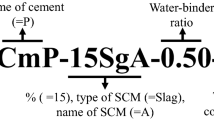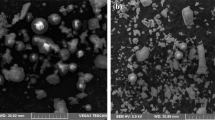Abstract
This chapter presented the effect of fly ash on the mechanical properties of Ground-Granulated Blast Furnace Slag (GGBFS) or Slag-based Alkali-Activated Concrete (SAAC) cured at room temperature with low NaOH concentrations. Using 100% GGBFS, three concrete classes were evaluated in this study: 20, 40, and 60 MPa (GGBFS). GGBFS was replaced with fly ash at 0%, 20%, 40%, 60%, 80%, and 100% in this investigation and low NaOH concentrations 1, 2, and 4 M were used. In this chapter, mechanical aspects compressive, split tensile, flexural strengths, and stress–strain relation studied. Also, from stress–strain relation, modulus of elasticity (MOE) values was determined. From the test results, the flexural strength and split tensile strength values were slightly decreased when the fly ash content was substituted from 0 to 40% and these strength values reduced greatly when more than 40% fly ash was substituted. A correlation was established between compressive strength, split tensile strength, and flexural strengths of all mixes according to the various code provisions, and the derived relations have been compared with past studies and code provisions. The developed empirical relations satisfied the most of codes and studies. Measured modulus values were drastically decreased as the fly ash increased more than 40%. Based on obtained stress–strain relationship, the maximum strain decreased as compressive strength increased. When the fly ash replacement increased from beyond 40% in 40 MPa and 60 MPa concrete grades, the (MOE) decreased by 40%–90%, while it decreased by 35%–90% in 20 MPa concrete.
Access this chapter
Tax calculation will be finalised at checkout
Purchases are for personal use only
Similar content being viewed by others
References
Duxson P, Provis JL, Lukey GC, Van Deventer JS (2007) The role of inorganic polymer technology in the development of green concrete. Cement Concr Res 37(12):1590–1597. https://doi.org/10.1016/j.cemconres.2007.08.018
Chindaprasirt Prinya T, Chareerat VS (2007) Workability and strength of coarse high calcium fly ash geopolymer. Cement Concr Compos 29(3):224–229. https://doi.org/10.1016/j.cemconcomp.2006.11.002
Wongpa J, Kiattikomol K, Jaturapitakkul C, Chindaprasirt P (2010) Compressive strength, modulus of elasticity, and water permeability of inorganic polymer concrete. Mater Des 31(10):4748–4754. https://doi.org/10.1016/j.matdes.2010.05.012
Bondar D, Lynsdale CJ, Milestone NB, Hassani N, Ramezanianpour AA (2011) Effect of type, form, and dosage of activators on strength of alkali-activated natural pozzolans. Cement Concr Compos 33(2):251–260. https://doi.org/10.1016/j.cemconcomp.2010.10.021
Puertas F, Martinez Ramirez S, Alonso S, Vazquez T (2000) Alkali-activated fly ash/slag cements: strength behaviour and hydration products. Cement Concr Res 30(10):1625–1632. https://doi.org/10.1016/S0008-8846(00)00298-2
Srikrishna TC, Rao TDG (2018) Appraisal on strength characteristics of alkali-activated GGBFS with low concentrations of sodium hydroxide. Iran J Sci Technol Trans Civil Eng 42(3):231–243. https://doi.org/10.1007/s40996-018-0113-4
Mallikarjuna Rao G, Gunneswara Rao TD (2015) Final setting time and compressive strength of fly ash and GGBS-based geopolymer paste and mortar. Arab J Sci Eng 40(11):3067–3074. https://doi.org/10.1007/s13369-015-1757-z
Mallikarjuna Rao G, Gunneswara Rao TD, Siva Nagi Reddy M, Rama Seshu D (2019) A study on the strength and performance of geopolymer concrete subjected to elevated temperatures. Recent Adv Struct Eng 1:869–889. https://doi.org/10.1007/978-981-13-0362-3_70
Chi M (2012) Effects of dosage of alkali-activated solution and curing conditions on the properties and durability of alkali-activated slag concrete. Constr Build Mater 35:240–245. https://doi.org/10.1016/j.conbuildmat.2012.04.005
Lee NK, Lee HK (2013) Setting and mechanical properties of alkali-activated fly ash/slag concrete manufactured at room temperature. Constr Build Mater 47:1201–1209. https://doi.org/10.1016/j.conbuildmat.2013.05.107
Fang G, Ho WK, Tu W, Zhang M (2018) Workability and mechanical properties of alkali-activated fly ash-slag concrete cured at ambient temperature. Constr Build Mater 172:476–487. https://doi.org/10.1016/j.conbuildmat.2018.04.008
Fernandez JA, Palomo A, Lopez HC (2006) Engineering properties of alkali activated fly ash concrete. ACI Mater J 103(2):106–112. https://doi.org/10.14359/15261
Bernal SA, de Gutiérrez RM, Pedraza AL, Provis JL, Rodriguez ED, Delvasto S (2011) Effect of binder content on the performance of alkali-activated slag concretes. Cem Concr Res 41(1):1–8. https://doi.org/10.1016/j.cemconres.2010.08.017
Ryu GS, Lee YB, Koh KT, Chung YS (2013) The mechanical properties of fly ash-based geopolymer concrete with alkaline activators. Constr Build Mater 47:409–418. https://doi.org/10.1016/j.conbuildmat.2013.05.069
Nath P, Sarker PK (2014) Effect of GGBFS on setting, workability and early strength properties of fly ash geopolymer concrete cured in ambient condition. Constr Build Mater 66:163–171. https://doi.org/10.1016/j.conbuildmat.2014.05.080
Goriparthi MR, Gunneswara Rao TD (2017) Effect of fly ash and GGBS combination on mechanical and durability properties of GPC. Adv Concr Constr 5(4):313. https://doi.org/10.12989/acc.2017.5.4.313
Kamal N (2016) Fly ash and GGBFS based powder-activated geopolymer binders: a viable sustainable alternative of portland cement in concrete industry. Mech Mater 103:110–122. https://doi.org/10.1016/j.mechmat.2016.09.012
Ivan D-L, Allouche EN, Vaidya S (2011) Mechanical properties of fly-ash-based geopolymer concrete. ACI Mater J 108(3):300. https://doi.org/10.14359/51682495
**e J, Wang J, Rao R, Wang C, Fang C (2019) Effects of combined usage of GGBS and fly ash on workability and mechanical properties of alkali activated geopolymer concrete with recycled aggregate. Compos B Eng 164:179–190. https://doi.org/10.1016/j.compositesb.2018.11.067
Thomas RJ, Peethamparan S (2015) Alkali-activated concrete: Engineering properties and stress–strain behaviour. Constr Build Mater 93:49–56. https://doi.org/10.1016/j.conbuildmat.2015.04.039
Venu M, Gunneswara Rao TD (2018) An experimental investigation of the stress-strain behaviour of geopolymer concrete. Slovak J Civil Eng 26(2):30–34. https://doi.org/10.2478/sjce-2018-0011
IS:12089-1987 (1987) Specification for granulated slag for the manufacture of portland slag cement
IS 3812 (Part 1):2003 (2003) Indian standard pulverized fuel ash specification part 1 for use as Pozzolana in Cement, Cement Mortar and Concrete
IS 383 (2016) Indian standard coarse and fine aggregate for concrete. bureau of Indian standards
IS 9103:1999 (1999) Indian Standard concrete admixtures—specification
BS 5075-1: Concrete admixtures part 1: specification for accelerating and retarding water-reducing admixtures
Srikrishna TC, Rao TDG (2018) Mix design procedure for alkali-activated slag concrete using particle packing theory. J Mater Civ Eng 30(6):04018113. https://doi.org/10.1061/(ASCE)MT.1943-5533.0002296
IS:516-1959 (1959) Indian Standard methods of tests for strength of concrete
IS:5816 (1999) Indian standard splitting tensile strength of concrete method of test. Bureau of Indian Standards
ASTM C-293-02 (2002) Standard test method for flexural strength of concrete (using simple beam with center-point loading). International Standard Organization
Standards Australia (2001) Concrete structures, AS3600–2001
Sofi M, Van Deventer JSJ, Mendis PA, Lukey GC (2007) Engineering properties of inorganic polymer concretes (IPCs). Cem Concr Res 37(2):251–257. https://doi.org/10.1016/j.cemconres.2006.10.008
ACI M318-05 (2005) Building code requirements for structural concrete and commentary. American Concrete Institute
Code P (2005) Eurocode 2: design of concrete structures-part 1–1: general rules and rules for buildings. British Standard Institution, London
Nath P, Sarker PK (2017) Flexural strength and elastic modulus of ambient-cured blended low-calcium fly ash geopolymer concrete. Constr Build Mater 130:22–31. https://doi.org/10.1016/j.conbuildmat.2016.11.034
Author information
Authors and Affiliations
Corresponding author
Editor information
Editors and Affiliations
Rights and permissions
Copyright information
© 2024 The Author(s), under exclusive license to Springer Nature Singapore Pte Ltd.
About this paper
Cite this paper
Venkateswarlu, M., Gunneswara Rao, T.D. (2024). Influence of Fly Ash on Mechanical Properties of Slag-Based Alkali-Activated Concrete with Low NaOH Concentrations. In: Pancharathi, R.K., K. Y. Leung, C., Chandra Kishen, J.M. (eds) Low Carbon Materials and Technologies for a Sustainable and Resilient Infrastructure . CBKR 2023. Lecture Notes in Civil Engineering, vol 440. Springer, Singapore. https://doi.org/10.1007/978-981-99-7464-1_11
Download citation
DOI: https://doi.org/10.1007/978-981-99-7464-1_11
Published:
Publisher Name: Springer, Singapore
Print ISBN: 978-981-99-7463-4
Online ISBN: 978-981-99-7464-1
eBook Packages: EngineeringEngineering (R0)




